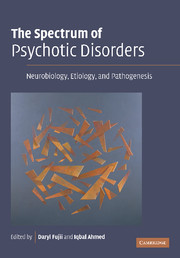Book contents
- Frontmatter
- Contents
- List of Contributors
- Preface
- Acknowledgements
- Part I Introduction
- 1 Introduction: Is Psychosis a Neurobiological Syndrome?
- Part II Primary Psychotic Disorders
- Part III Mood Disorders
- Part IV Neurodevelopmental and Genetic Disorders
- Part V Central Nervous System Disorders
- Part VI Substance Abuse and Medications
- Part VII Neurodegenerative Disorders
- Part VIII Sensory Impairments
- Part IX Conclusion
- Index
- References
1 - Introduction: Is Psychosis a Neurobiological Syndrome?
from Part I - Introduction
Published online by Cambridge University Press: 06 January 2010
- Frontmatter
- Contents
- List of Contributors
- Preface
- Acknowledgements
- Part I Introduction
- 1 Introduction: Is Psychosis a Neurobiological Syndrome?
- Part II Primary Psychotic Disorders
- Part III Mood Disorders
- Part IV Neurodevelopmental and Genetic Disorders
- Part V Central Nervous System Disorders
- Part VI Substance Abuse and Medications
- Part VII Neurodegenerative Disorders
- Part VIII Sensory Impairments
- Part IX Conclusion
- Index
- References
Summary
Psychosis is a state in which the individual experiences a severe disconnection from reality. The most common symptoms associated with psychotic disorders are delusions and hallucinations. Delusions are false beliefs about experiences, oneself, or the environment that cannot be altered in the face of contradictory evidence. An example would be delusions of persecution in which the individual believes that others are tormenting, ridiculing, or intending to harm him or her. Hallucinations involve false perceptions in any sensory modality without insight into their pathological nature. The most common hallucination is auditory, which is generally experienced as “hearing voices.” Other symptoms associated with psychotic disorders include negative symptoms such as restricted emotional expression (flat affect), sparse language output (alogia), poor initiation and persistence of goal-directed behaviors (avolition), disorganized thoughts, speech, or behaviors, or a severe decrease in reactivity to one's surroundings (catatonia) (American Psychiatric Association, 2000).
Psychosis has many etiologies. The Diagnostic and Statistical Manual-IV Text Revision (DSM-IV TR) (American Psychiatric Association, 2000) distinguishes between primary psychotic disorders and those due to other etiologies. Primary psychotic disorders include schizophrenia, delusional disorders, schizoaffective disorder, schizophreniform disorder, and brief psychotic disorder. By contrast, psychosis can be due to a general medical condition such as Dementia of the Alzheimer's Type (DAT) or traumatic brain injury (TBI), a psychoactive substance such as amphetamines or cannabis, or secondary to a mood disorder such as major depression. The following are brief descriptions of the DSM-IV TR diagnostic criteria for each disorder:
Diagnostic criteria for schizophrenia
A. Two or more of the following symptoms are present: (1) delusions, (2) hallucinations, (3) disorganized speech, (4) grossly disorganized or catatonic behavior, and (5) negative symptoms.
[…]
- Type
- Chapter
- Information
- The Spectrum of Psychotic DisordersNeurobiology, Etiology and Pathogenesis, pp. 3 - 12Publisher: Cambridge University PressPrint publication year: 2007



